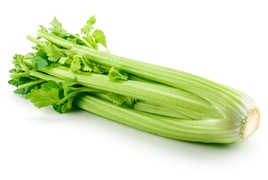
CELERY
Celery has green, crunchy stalks with leaves at the top all joined to the same root. Green celery is related to celeriac but with celeriac it’s the root that we eat while celery is the plant above ground.
Fresh celery is often springy and juicy and has quite a strong flavor. Try adding slices of celery to soups and casseroles for a fuller flavor. Or use it as a cocktail stick and a snack in the classic tomato juice cocktail, a Bloody Mary.
Choosing celery
Look for springy bunches without any wilting leaves. Lighter celery tends to have a milder, more watery flavor.
Slightly depending on the season and deliveries, bunches of celery can have a few chunky stalks or more smaller ones. It doesn’t really involve any difference in flavor but the shape can affect how you chop and cut it.
Even wilted celery works in a casserole, but you ought to be able to get a discount.
Storing celery
It’s best to keep it in the original packaging. The material and the design will have been produced to keep the contents fresh for as long as possible.
If the celery doesn’t have any packaging, put it in a plastic bag and put the bag in the fridge.
If the celery starts to wilt, wrap it in paper and put it in water.
Preparing celery
Rinse the celery and cut off the bottom, coarsest part and the top, dry end.
Cut off and save the leaves and use them as nicely bitter elements in a salad.
If you’re adding celery to a casserole, it’s good finely chopped. That way you avoid getting the threads of fiber in your dinner and the celery melts into the sauce almost like chopped onion.
How to cook celery
The stalks can be cut into shorter chunks and used as sticks for dips, e.g. blue cheese with walnuts. They can also be sliced thinly and mixed in salads, often with apples or carrots.
Warm, they go well in a soup, sauce or as a celery casserole. Never heard of a celery casserole? Try something new, see below.
Not everyone loves the flavor of raw celery but as a base ingredient in stews – or in bolognese sauce – it has an ability to raise other flavors, particularly meat and umami, to dizzy heights.
More flavor in sauces and stews: Finely chop the celery and use it to add more flavor to tomato sauce, bolognese sauce or veal stroganoff.
Make a vegetable soup: Cut the celery into pieces and fry with onion, garlic and vegetables of your choice. Pour vegetable stock over the top and simmer for 10 minutes until your vegetable soup is ready.
Make Khoreshte karafs, a Persian celery casserole with parsley, mint, lime and saffron. Google the recipe.
Serving celery
In a Bloody Mary – and you can steal the idea for any tomato dish in principle – celery is a star. But it’s probably more common for it to stay in the background – in the fond – and lift the other flavors on the plate.
For a beautiful, aromatic presentation, cut thin shavings of celery with a mandoline or cut thin sticks with a sharp knife to make an attractive tangle.
The classic
The most nutritious cocktail stick ever is the one in a Bloody or Virgin Mary. Celery is perfect here.








